Art is an integral part of the fabric of a city. It helps tell the story of the city, creates a unique sense of place, contributes to neighborhood vitality, and stimulates new economic activity. BCA's Art in Public Places program supports the development of art in the public realm that is creative, well crafted and integrated into the physical, cultural, and historical context. For more information or to be notified of public art opportunities, please contact Colin Storrs, Public Art and Grants Program Manager.
Learn more about Burlington's Percent For Public Art Ordinance and read the ordinance here.

Bank Street Murals
2019
Burlington City Arts and The City of Burlington’s Community and Economic Development Office collaborated on this temporary mural project, which invited artists to paint panels around the construction barriers surrounding the City Place Burlington site on Bank and Cherry Streets. Twenty five artists were selected to participate in the project and completed the work on site in a day. The purpose of the mural project was to help mitigate the impact of construction for the local community by showcasing the breadth of talent in Vermont. In the months after the completion of the murals, Brookfield, a majority owner of the City Place project, announced it would leave the partnership, leaving the project’s completion date in limbo.
Artists: Scottie Raymond, Ron Hernandez, Wylie Garcia, Corinne Yonce, Sunniva Dutcher, Abby Manock, Kat Lawlis, Phillip Godenschwager, Emily Bundock, Lydia Ode, Caitlin La Dolce, Max Hodgwon, Mary Hill, Cole Glover, Elizabeth Harris, Meili Stokes, Nikki Laxar, Maggie Standley, Eric Newman, Brian Clark, Shastina Ann-Wallace, Clark Derbes, Robert Hitzig, Jess Graham, Tony Shull










Cherry Street Murals
2019
Burlington City Arts and The City of Burlington’s Community and Economic Development Office collaborated on this temporary mural project, which invited artists to paint panels around the construction barriers surrounding the City Place Burlington site on Bank and Cherry Streets. Twenty five artists were selected to participate in the project and completed the work on site in a day. The purpose of the mural project was to help mitigate the impact of construction for the local community by showcasing the breadth of talent in Vermont. In the months after the completion of the murals, Brookfield, a majority owner of the City Place project, announced it would leave the partnership, leaving the project’s completion date in limbo.
Artists: Scottie Raymond, Ron Hernandez, Wylie Garcia, Corinne Yonce, Sunniva Dutcher, Abby Manock, Kat Lawlis, Phillip Godenschwager, Emily Bundock, Lydia Ode, Caitlin La Dolce, Max Hodgwon, Mary Hill, Cole Glover, Elizabeth Harris, Meili Stokes, Nikki Laxar, Maggie Standley, Eric Newman, Brian Clark, Shastina Ann-Wallace, Clark Derbes, Robert Hitzig, Jess Graham, Tony Shull

















Clark Derbes Mural
2017
Clark Derbes created this mural working with youth from the King Street Center and a grant from the BCA Community Fund. His recognizable geometric style has been seen in sites throughout Burlington, from the Moran plant prior to brick demolition, to traffic control boxes, to parked tractor trailers.

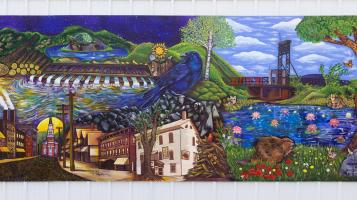
Let It Be: A Cautionary Tale of the Pine Street Barge Canal
2025
Created by Juniper Creative Arts in collaboration with youth apprentices through BCA’s Artist Apprenticeship Program, this mural was inspired by research, conversations with local experts, and archival study. It reflects the Barge Canal’s complex environmental history, its often-overlooked cultural past, and the possibilities of renewal when nature is allowed to thrive. Paired with audio stories captured by Vermont Folklife, the work reminds us that while the past cannot be changed, the future can be one of healing and hope.
Listen to audio stories from the Barge Canal Mural Brigade!
Juniper Creative Arts: Will Kasso Condry, Jennifer Herrera Condry, and Alexa Herrera Condry
BCA Teaching Assistants: Gloria Kigonya and Sofia Tudzarov
BCA Artist Apprentices: Richie Amerson, Mateo Baker-Djele, Nico Jastatt, Bella Listi, Calvin Millham-Berry, Coretta Ngoulaki, Levi Olsen, Ellie Traxler-Menz.

The ONE Mural Project, Front Street
Mary Lacy and Sloan Collins
North St and Front St
2016
This is one of three murals Lacy and Collins designed for the Old North End of Burlington that incorporates portraits of neighborhood kids. The artists organized over 50 different kids to paint the murals through the Sarah Holbrook Center, the Integrated Arts Academy, the Ramble, and word of mouth. The third mural was originally located behind 74 North St.


The ONE Mural Project, Intervale Ave
Mary Lacy and Sloan Collins
Intervale Ave and Achibald St
2016
This is one of three murals Lacy and Collins designed for the Old North End of Burlington that incorporates portraits of neighborhood kids. The artists organized over 50 different kids to paint the murals through the Sarah Holbrook Center, the Integrated Arts Academy, the Ramble, and word of mouth. The third mural was originally located behind 74 North St.



Wish
Gowri Savoor and James Westermann
2015, Stainless steel
Commissioned by Redstone for the development of a residential building at 247 Pearl Street, "Wish"is a wall-based public sculpture that takes the form of a dandelion seed. A
popular symbol of myth and legend, the dandelion symbolizes wishes that come true. Frequently
known as the ‘wishing clock’, the image has a timeless quality that is easily recognizable the world
over. Commonly it is found growing as a weed yet it has multiple uses--including both medicinal
and culinary purposes. This herbal plant has deep roots, is strong, resilient and embodies the spirit
of Vermont.


You are Loved
Alex Cook
2017
This mural was in created in partnership with the US Attorney’s Office to raise awareness about human trafficking. Cook made the initial outline and then the mural was filled in by victims, friends and family, federal employees. Since 2013 he has painted 42 You Are Loved murals in nine state, but this one is unique for its message encouraging women to reach out for help: "Addicted? Need help? Dial 211. US Attorney’s Office, District of VT, Supporting victims of drug and human trafficking.”

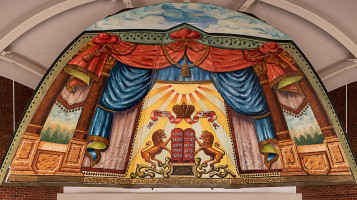
The Lost Mural
The Lost Mural
Ben Zion Black
1910, painted on plaster on lath board, 25 feet wide, 12 feet high, 6500 pounds
Location: Ohavi Zedek Synagogue Lobby, 188 North Prospect Street, Burlington, Vermont.
Available to the public during normal business hours.
See the website for more information on the rescue, relocation and restoration of the Lost Mural: www.lostmural.org
Tours are also arranged through the website if desired.
The Lost Mural is representative of an art form, the painted wooden synagogues, that was once prevalent in Eastern Europe and is a rare surviving example of a painted wall mural in a synagogue. It was painted in 1910, hidden in 1986, moved in 2015 and fully restored in 2021-2022.
The Lost Mural Project is dedicated to educating the public about the Lost Mural, the Burlington immigrant Jewish Community, (formerly called “Burlington’s Little Jerusalem”), and all immigrant groups who have found a home either in our region or across the state.
More information at www.lostmural.org and PBS Documentary.
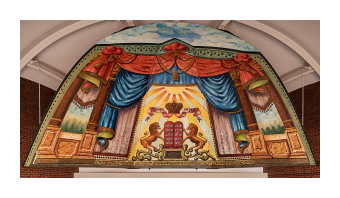

Millennium Sculpture
1999, granite, stainless steel
The transition from the second to the third millennium was reason for much celebration and speculation worldwide. It also prompted the commissioning of this public artwork, a 24-foot-high futuristic spire mounted on granite columns that safeguards an underground time capsule. The pendulum gong gently marks the passage of time. The sculpture was unveiled at a memorable First Night ceremony, which included a John Gailmore sing-along performance, a laser light show, and the entombment of the time capsule. The time capsule contains messages for the next millennium from citizens of many ages and backgrounds, and is intended to be reopened in 2099.
Commissioned by Burlington City Arts and First Night Burlington

Foundations
Waterfront Park parking lot
1998, oxidized copper
The Burlington Department of Public Works worked with Burlington City Arts’ public art program to provide a decorative element to a new parking lot adjacent to the foundation wall of the former Pease Grain Company, a fixture on the Burlington Waterfront from the late 1800’s to the 1970’s. The site had become dilapidated and marked with graffiti in the period prior to the renewal of the Waterfront. Created from oxidized copper panels with swirling blue and green tones, the sculpture references the past industrial prominence in its use of materials and the current recreational focus of the Waterfront area in design. The wall has remained virtually free of graffiti since the 1998 installation.
Photo by Michael Weizenegger


City Place Community Art Murals - South
King Street Mural
Three sides of this building hosts murals created by King Street Center Youth, Burlington High School Students and Reta A. Masters at the McClure Senior Center in 2015. At that time, the plan for the stalled City Place renovation had been in early stages.
Burlington City Arts coordinated their development for the mall owner, working with teaching artist Alyssa Faber, who facilitated artmaking workshops with each group around the theme, “What does Burlington mean to me.” The mural facing Lake Champlain was created by Burlington High School Art 2 Honors students Georgia Essig, Alicia Breen, and Nikki Miller. The mural facing south was created by King Street Youth Barni Hassan, Nikkiah Atwood and Zanaia Hanmond. The mural facing east was created by Reta A. Masters at the McClure Senior Center.The fourth side of the building was already wrapped by in a photo muralby L.L. Bean.
From high-resolution photos, the selected images were enlarged and printed by Sign Depot of Vermont, who installed the images in sections over the walls and windows with a material that does not obscure the windows from within.



So. Co: File Under
208 Flynn Avenue
2002-2020, mixed media
In 2002, artist Bren Alvarez created "File Under So. Co., Waiting for…," an art installation raised in response to a long-delayed roadway, the Southern Connector (now the Champlain Parkway). Also known as the "World's Tallest Filing Cabinet," the piece was installed on the centerline of the planned roadway. As the City moved toward construction in 2020, Alvarez took the opportunity to move the local icon to a more permanent location adjacent to the site. In the process, she revised the base, adding additional height and new components that further reference the bureaucracy embedded in this legendary project. The sculpture is now the central feature of a new art park outside of 208 Flynn Ave.


Audeamus
Champlain College Finney Quad
2014, stainless steel
Located in the green space within the College's new Res-Tri residential community on the corner of Maple and South Willard Streets, now officially renamed "Finney Quad," the selection committee focused on a sculpture that would reflect Finney's passion for education, his drive for communication with students, faculty and staff, his elegance, personal character and his forward thinking, Dagan noted.
The 10-foot tall, stainless steel sculpture expresses the artist's idea of critical thinking made possible by dialogue, discussion and discourse with an underlying concept of boldness in education. Curtis achieved this by creating two abstract figures engaged in some sort of interaction or conversation, vague enough to invite interpretation, but explicit enough to be decodable by viewers.


Unlocked
University Green
2008, granite
This work was donated to UVM by a collector of Chris Curtis' work in 2016. Curtis, a 1974 alum, is well-known for his work in stone. Like many of Curtis’ works, the deeper meaning of “Unlocked” is up to interpretation, which he prefers for its college campus location.



Venus
Main Street Landing Lakestreet entrance
2005, glacial boulder
Curtis both transforms the stone and preserves the integrity during the process of sculpting. In this case, the polished curved surfaces complement the original curves of the natural stone. While the result suggests a heart, the entire piece is intended to represent fertility."


Big Joe Burrell
Church Street Marketplace Top Block
2010, Bronze
After more than 5 years of community planning and fundraising, Big Joe Burrell was unveiled in front of Halvorson’s Upstreet Café on June 4th, 2010 for the opening night of the Discover Jazz Festival. Sharp based the statue on a photo of Burrell taken in by artist Josef Cernikovsky. The site was selected because Big Joe performed regularly at Halvorson’s on Thursday evenings in the last years of his life. The commemorative sculpture is a permanent reminder of his unforgettable contribution to music in Vermont.

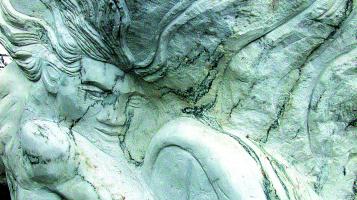
Water Treatment Plant Sculpture Collection
Roundhouse Park
1992, marble
Located on the water's edge in Roundhouse Park, this grouping of sculptures is part of a project conceived and coordinated by Justin Rose. Rose was one of Paul Aschenbach’s students at UVM and it was there that he developed an interest in collaborative work. While Aschenbach encouraged the agreement of an overarching theme to provide a sense of unity in collaborative work, Rose preferred a loose concept tied together by the process of creating sculpture on site, a theme exaggerated here by the fact that each artist created and left behind sculpture exactly on the site where the marble was found along the water’s edge. This process draws attention to Burlington’s unnatural geological history, since much of the city is actually built on marble fill used to reduce its originally swampy nature.
The Wave, By Christopher Spath, 1992 (Pictured)
El Sol, By Justin Rose, 1992
Rollerblades, By Paul Aschenbach, 1992
Pegasus, By Pat deGogorza, 1992
Merman, By Pat deGogorza, 1993
Mermaid, By Pat deGogorza, 1993
Champ, By Justin Rose, 1993
Canoe, By Andy Arp, 1993
The Lighthouse, By Paul Aschenbach, 1992
Photo by Michael Weizenegger


The Burlington Earth Clock
Oakledge Park
2007, granite
The Burlington Earth Clock is the first project of Circles for Peace, a Vermont grassroots non-profit organization that is based on the philosophy that inner peace and inner strength can be restored by witnessing the rhythms and cycles of nature.
The Burlington Earth Clock is a 43½-foot circle of 14 granite stones that creates a clock, compass and calendar. The stones weigh between 3.5 and 20 tons. The Earth Clock measures the sun’s journey north and south along the horizon through the cycle of seasons. In the center of the circle is a sundial. When you stand on the date line in the center of the sundial, your shadow tells the time of day.
Photo courtesy of David Brizendine.

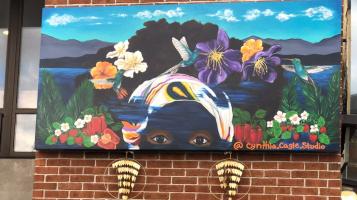
Ferene Existing While Black
CYNTHIA CAGLE, Artist and Design Collaborator
@cynthia.cagle.studio
FERENE PARIS MEYER, Storyteller & Founder CEO of All Heart Inspirations
@allheartinspirations
AISHA MCLAREN, Founder and Maker at Soul Simone, Earring Design
@_soulsimone
TANYA TALAMANTE, Design Collaborator
@tanya.talamante
Ferene Existing While Black explicitly and implicitly signifies the emancipation of enslaved people celebrated on Juneteenth. The core concept of the mural is invisibility contrasted with the full vibrancy of Black identity. The mural is inspired by the poem “I Am From All of Me Is Tired,” by Ferene Paris Meyer. The mural is a portrait of Ferene—a local storyteller, mother, Vermonter and queer Haitian Black woman. Surrounding her are hummingbirds, flowers and fruits native to Haiti, and traditional red Juneteenth foods meant to symbolize resilience. Earrings hang down from the bottom of the mural, reflecting the light of her inner brilliance. In the background is the landscape of Lake Champlain backed by the Adirondacks, locating the image in the City of Burlington. Of significance are the gaps in the portrait revealing the landscape behind. The message is clear: there are parts of being Black in America that remain unseen. Invisible. We have cause to celebrate our history, but we should be seen all the time. The mural highlights the significance of Juneteenth not just as a vitally important moment of history, but as part of the richness of Black lives being lived joyfully and intentionally right now, today, in our city.
Listen to Ferene Paris Meyer read I Am From All Of Me Is Tired HERE. This audio file contains explicit language.
ARTIST BIO
Cynthia Cagle, a Chicana artist from Los Angeles, moved to Vermont in 2004. Since arriving in Vermont, Cynthia has taught art and pottery, as well as exhibited at various community locations. She has worked in many mediums, primarily oil but also graphite, acrylics, watercolors, chalks, clay, charcoal and various inks. Street art—especially murals—has a rich and varied history within Latin American culture. Murals can be a vehicle for personal expression, historical events, and political statements. Most importantly, urban murals often tell stories left out of mainstream narratives. Drawing on this history and her own background, artist Cynthia Cagle provides the foundation for a rich amalgamation of powerful female artists that root the project within the local community
Commissioned by Burlington City Arts and the Office of Racial Equity, Inclusion and Belonging
Juneteenth 2021
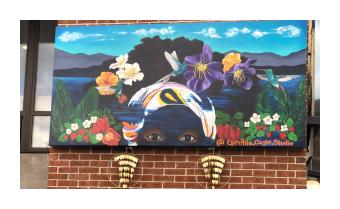
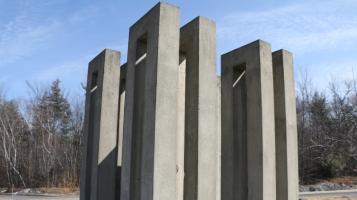
Sculpture on the Highway
I-89, Williston, Southbound rest area
1971, concrete
The Sculpture on the Highway project was the result of two International Sculpture Symposiums organized by Paul Aschenbach, the first in 1968 at the Vermont Marble Company in Proctor, and the second in 1971 at S.T. Griswold Company, Inc., in Williston. Aschenbach worked with the European Sculptor’s Symposium to select artists from all over the world with experience in both stone sculpture and the concept of symposium. A total of 18 sculptures were produced over the course of both symposiums and placed along rest areas on Interstates 89 and 91 from Highgate to Guilford, Vermont. Both of the newly renovated Williston rest areas exhibit sculptures from the Symposiums.

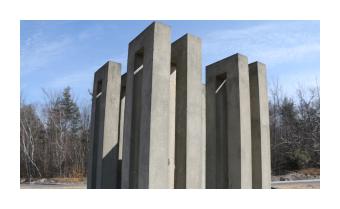
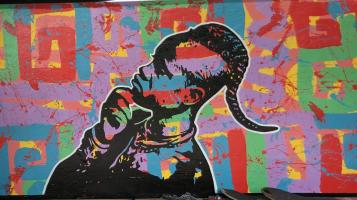
The Silent Symphony
The Silent Symphony is about being fearless and uniting as one. The young tribal women and man are displayed wearing traditional African wardrobes. With the tradition being passed down from our ancestors, they continue to honor these customs and maintain unity within their tribe. Looking beyond, each individual shows that they are standing together, strong and fearless. The imagery conveys Juneteenth's significance, telling the story of strong African people who have endured so much, finally standing tall and fearless. It shows where our culture came from and where we are now. We have risen from the depths, we are free, we are loud, and we will continue to unite and fight with love and pride. The greatest symphony that was once silenced, is now for all to hear.
Egypt Hagan is an emerging artist and muralist from Los Angeles, California. She moved to New York where she held her first solo exhibition in 2014. Egypt currently resides and works out of Tampa, Florida. Throughout her work, Egypt uses portraiture as storytelling. “We as humans bare a unique story. I enjoy creating these stories not with the use of words, but bold images and an underlying vibrancy that emphasizes the main subject. My paintings consist of people or moments I've come across that have inspired my journey here on Earth, untold stories that deserve to be heard.” Egypt is well known for her vibrant colors and cultural images. Today, Egypt continues to work on numerous projects and commissions while exhibiting her artwork around the world.
Commissioned by Burlington City Arts and the Office of Racial Equity, Inclusion and Belonging
Juneteenth 2021
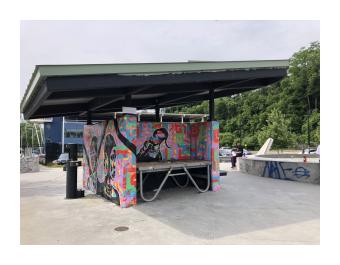
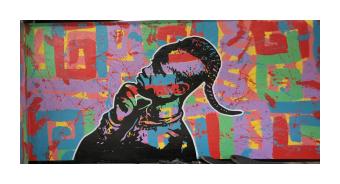

A Forest
A Forest
Elizabeth Billings, Andrea Wasserman
wood and mirror glass panels
October 2022
"A Forest" celebrates the essence of Vermont’s natural beauty through a harmonious blend of carved wooden panels and etched mirrored glass. This artwork reimagines Maple, Apple, Birch, a previous installation created by the artists for Burlington International Airport in 2001.
The new piece transforms the original wooden elements into a striking composition that evokes the tranquility of a forest pathway. Interwoven textures and patterns suggest light filtering through leaves, branches mingling overhead, and the play of shadows on the ground, capturing the spirit of Vermont's landscapes.
Commissioned by Burlington International Airport and Burlington City Arts, A Forest enhances its surroundings by merging natural inspiration with architectural elegance, offering travelers a serene moment of reflection amid their journey.


Brightly Colored Trees
2015, wood, steel and fiberglass
This was the second piece commissioned by Redstone as part of its development of the Hilton Garden Inn. This piece was a more permanent recreation of a past project made for an outdoor exhibition in Stockbridge, Massachusetts, and then later installed at the Maltex building. Fiberglass casts of trees and lit from within at night, the piece continues the artist's intere in nature vs the human-made environment.


Mushroom Grove
2015, wood, steel and fiberglass
This piece was commissioned by Redstone as part of its development of the Hilton Garden, which incorporated the historic armory building into a contemporary building that snakes throughout the block. The sculpture references the complicated relationship between development and nature in a city, emphasized by the organic forms made from unnatural materials.

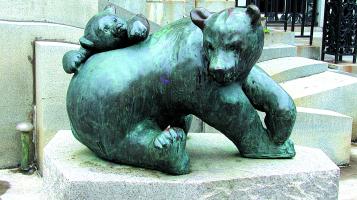
Deer and Bear Fountain
City Hall
1982, bronze
Frank Stout originally proposed two abstracted female forms for this location, but the Mayor and the finance board of the City Council rejected the proposal as unrecognizable and inappropriate subject matter. Stout responded by turning in another “realistic” proposal of the Deer and Bear sculptures that now flank the entrance of City Hall. One could say that the subjectmatter references Vermont’s commitment to protecting its natural habitats through environmental laws.
Photo by Michael Weizenegger



Kindred Spirits
UVM Fleming Museum
1991, painted steel
Smith created this piece while serving as an artist-in-residence at UVM. While his vocabulary of forms draws heavily from traditional African Art, his work is easily categorized as Abstract Expressionist. Kindred Spirits’ placement at the Fleming Museum set the stage for an exhibition of Smith’s drawings and smaller sculpture at the museum in 1999.
Photo by Michael Weizenegger


City Place Community Art Murals - West
Burlington High School Mural
2015
Three sides of this building hosts murals created by King Street Center Youth, Burlington High School Students and Reta A. Masters at the McClure Senior Center in 2015. At that time, the plan for the stalled City Place renovation had been in early stages.
Burlington City Arts coordinated their development for the mall owner, working with teaching artist Alyssa Faber, who facilitated artmaking workshops with each group around the theme, “What does Burlington mean to me.” The mural facing Lake Champlain was created by Burlington High School Art 2 Honors students Georgia Essig, Alicia Breen, and Nikki Miller. The mural facing south was created by King Street Youth Barni Hassan, Nikkiah Atwood and Zanaia Hanmond. The mural facing east was created by Reta A. Masters at the McClure Senior Center.The fourth side of the building was already wrapped by in a photo muralby L.L. Bean.
From high-resolution photos, the selected images were enlarged and printed by Sign Depot of Vermont, who installed the images in sections over the walls and windows with a material that does not obscure the windows from within.


Flukes
2004, bronze
Davis Student Center
Gund made “Flukes” after a pod of whales beached near his house in Nantucket. He pushed on their tails to try to get them back into the ocean. Though he has lost his sight, he continues to create artwork and based this sculpture on his memory and the texture of the tails. Gund donated “Flukes” to the university in 2016, the alma mater of his two sons.


Embrace and Belonging
By Ai Qiu Hopen and Chen Hopen, Humanity Memorial Inc.
June 2024, stainless steel, steel, concrete and granite
Dewey Park
50 Spring Street
Burlington, VT
Representing our collective need to reflect on the past, learn, and build a better future together, Humanity Memorial created this monumental artwork following the 2020 social justice uprisings and racial reckoning. The sculpture embodies a form inspired by two entwined Sankofa birds that call us together to build a greater sense of belonging. The artwork proposes an evolution beyond mere tolerance to true integration, beyond mere acceptance to building enduring communal bridges.
Commissioned by Burlington's Racial Equity, Inclusion, and Belonging Office with support from Burlington Parks Recreation and Waterfront.



General William Wells
Battery Park, Battery Street
1914, bronze
This statue is a replica of an original erected in 1913 on the Gettysburg battlefield in Pennsylvania. In 1860, Wells joined the army and helped raise Company C, Vermont’s first regiment. He went on to become a state senator for Chittenden County. The statue is situated on a historic site that came under fire during the War of 1812 and is very near the site where Vermont soldiers gathered before leaving to fight in the Civil War.
Photo by Michael Weizenegger


Lafayette
UVM Green, N. Prospect Street
1883, bronze
Lafayette came to the Colonies from France expressly to help America gain independence from the British and quickly became a general in the army. John P. Howard gifted this piece to UVM to commemorate Lafayette’s visit to Vermont in 1825.
Photo by Michael Weizenegger


Unfailing Dialogue
Waterfront Park
2009, stainless steel
The two intertwined stems of this sculpture symbolize the strong bonds between Québec and Vermont. Leaves and letters represent complementarity and dialogue.
This sculpture was offered by Québec to the State of Vermont on the occasion of the 400th anniversary of Samuel de Champlain's arrival to the lake that now bears his name.
It was unveiled on July 10, 2009
photo by Steve Mease




Bird and Cattails
2020, stainless steel, fiberglass
After two years in process, this sculpture was installed on the corners of St. Paul Street and Maple Street two days before the pandemic shutdown operations in March. Depicting a larger-than-life red-winged blackbird perched on huge cattails, the sculpture references local ecology and the rain gardens they are installed within, creating an informal gateway to Burlington's downtown business district.
Pill and Sikora fabricated the sculpture at Generator's metal shop in the South End and at Arcana Workshop in Barre. The bird is sculpted out of foam, fiberglass and stainless steel, while the cattails are made of a patinated mild steel with polished stainless steel accents. The artists worked closely with Artisan Engineering and the City's project team to design a base that would provide the right support for the sculpture's 12-17 foot height without impeding the rain garden's function.
This project was commissioned as part of Burlington's Great Streets Initiative, a planning project designed to make new investments in the downtown's public infrastructure, that ensure that Burlington residents have a downtown that is a vibrant, walkable and sustainable. The design standards include provisions for public art and stormwater infrastructure.
Photos by Yeager Anderson




Amphibians
Waterfront Park
1991, granite
Produced after the ‘91 International Sculpture Symposium at William’s studio in Barre, Vermont, this work was carved out of a piece of granite split off from the tallest cornerstone of the composition at the Moran Plant. Originally intended to have an east/west orientation to serve as a solstice marker, the City decided on its present orientation and it became a sculpture without the calendar function. The two salamanders were intended to symbolize our dependence on clean waters and man’s amphibious origins. The general health of amphibians are a direct indication of the conditions of our fresh waters. The small carvings were vandalized within a few days after installation. The heads are missing but the bodies still remain visible.
Photo by Michael Weizenegger


Our Mountains Our Home
2018
This massive mural, spanning 206 feet, was commissioned by Outdoor Gear Exchange to improve the Cherry Street pedestrian experience and speak to the business' focus. Graham invited community volunteers to fill in the areas she'd blocked out with paint. During this period, a controversy was building in the downtown surrounding a similarly scaled mural, seen as not inclusive called "Everybody Loves a Parade." This mural avoids portraying recognizable individuals and focuses instead on recreational activities and nature.



Samuel De Champlain
Champlain College
2009, bronze, granite
The statue, which rests on a column of polished black granite from Quebec, depicts the French explorer as he might have looked in July 1609 when he arrived in the region by canoe. The 39-year-old explorer Champlain is posed kneeling, looking out on the lake with a spyglass. Sardonis said he wanted to offer a more modern interpretation of the famous explorer by including the telescope, which he saw as a metaphor for both education and knowledge, as well as a symbol for his vision of a new world. His image of Champlain also breaks some other statue stereotypes by making Champlain clean-shaven, shirtless and barefoot.
In recent years, the sculpture has elicited critique among the student body for disregarding the consequences of colonization for indigenous people. Chief Don Stevens, the chief of the Nulhegan band of the Coosuc Abenaki nation, has suggested adding an equally prominent statue representing the Abenaki rather than tearing down the statue of Champlain.


Whale Tails
30 Community Drive, Technology Park, Williston
1989, African black granite
The design for "Whale Tails" was originally a finalist for a museum front in Anchorage, Alaska, but the cost of producing the piece in bronze was greater than the museum’s budget. A friend of the artist, who planned to open a hotel in Randolph, then commissioned him to carry out the sculpture in granite for the hotel front. The Whale Tails were installed, but the hotel was never built, so the sculpture spent a decade in a dramatic open field in Randolph where they became a landmark on Interstate 89. When the property sold, the new developer saw the piece as an expense and a liability, and gave the previous owner a year to sell it. In 1999, the piece was sold to Technology Park to serve as the centerpiece of a walking path.
Photo by Michael Weizenegger


Skygates
Burlington International Airport
2004, acrylic and mixed media
With the expansion of gates 1 and 2, the Burlington International Airport wanted to commission an art piece that would make the travel experience exciting and help alleviate its associated anxieties. Using color, natural light, and a complex series of symbols, Sky Gates transforms the building’s four architectural sky light features into portals into human history that stir the imagination of every viewer. The murals were applied by alternating layers of acrylic paint and lines of lumber crayon, graphite and colored pencil. The yellow mural integrates scientific diagrams, formulas and equations. The red mural is structured by alphabets and other notational systems. The green mural is a tapestry of pictographs, symbols and iconography. The blue mural refers to the long history of ceiling painting and frescos and also contains elements of the yellow, red and green murals.
The expansion was designed by Freeman French Freeman Architects. Sky Gates was commissioned by Burlington City Arts.
Photo by Gary Hall



Archways
235 College Street (Fletcher Free Library)
1988, metal and plexiglas
This piece was made for the H.O. Wheeler School during a North End Beautification Project. Appropriately placed, Archways symbolizes the doorways of learning.


Andy A_Dog Williams
2016
This mural was painted as a tribute to DJ Andy "A-Dog" Williams, who died of leukemia in December 2013. A beloved creative, the surrounding skatepark was also named in his memory. The Friends for A-Dog Foundation, a devoted group of volunteers, also organizes annual fundraisers, awareness events andbone-marrow registration efforts.
Jozie Furchgott Sourdiffe, the talent behind this piece, was also Williams partner and continues her work as a fine artist in Miami, FL.


Lamentations
Fleming Museum
1989, scrap metal
This piece was inspired by choreographer Martha Graham's dance of the same title. Its somber tone eerily foreshadows the artist’s death soon after the piece was completed. The collection was donated to UVM by the Brown Family Foundation, and installed in a bosque of honey locusts outside the Fleming Museum until 2004, when they were moved to an indoor location due to deterioration. Over many years, artists and UVM have collaborated to raise awareness and funds to restore each figure and return them to the bosque one by one. The works were restored by Jeffrey Sass, an artist who worked for Brown and actually fabricated the original sculptures from crushed oil tanks, corrugated roofing, Volkswagen fenders and other car parts.


All that Jazz: Portrait of Matthew Evan Taylor
ONE Community Center
2020
“All that Jazz” depicts composer, saxophonist, and Middlebury College music professor Matthew Evan Taylor playing a saxophone in an Afrofuturistic abstract style. The mural features abstract botanical and nature elements typical of Juniper Creative’s aesthetic. Will chose Taylor as the subject of this improvisational design to celebrate and uplift Black creativity. The mural was commissioned by the Champlain Housing Trust for the ONE Community Center.
Juniper Creative Arts is a Black and Dominican family collective with a mission-driven practice of creating art that both involves and celebrates historically excluded communities. Consisting of mural artist and illustrator Will Kasso Condry, creative director and concept designer Jennifer Herrera Condry, and their daughter, visual artist and photographer Alexa Herrera Condry, they use visual art and murals to lift up the voices, images, and people that are often left in the margins. Their work and vibe are inspired by their cultural and spiritual lineages, urban art, Hip-Hop culture, the mystical, and the natural world. They believe in the power of the arts to heal, bring people together, build community, create dialogue, and celebrate Black, Indigenous, and People of Color (BIPOC) lives and stories.


Kelis the Afronaut
Champlain Elementary
2020
Kelis the Afronaut was created by Juniper Creative in collaboration with dozens of young people from Burlington. This afro-futurist mural showcases a Black warrior named Kelis, who was conceived by the family artist collective, Juniper Creative Arts, as a symbol of joy, love, resilience, and a revolutionary spirit. The mural is the first in the Afro-Pollinator series by the artists which features powerful figures of color that emphasize interconnectedness and mutual co-existence with the natural world.
This project was made possible through a community-led fundraising effort, and the mural represents an effort to highlight the experiences of black and brown people in the community through powerful and joyful storytelling. As a strong symbol of tenderness and love, Kelis represents Black Joy as an act of rebellion against oppression, racism, and injustice. The poppy in her hands honors the lives of those who fought and died in the many revolutions against colonialism, slavery, and oppression.
The Wings around Kelis are made up of 300 individual pieces of artwork created by students from Champlain Elementary School and youth from King Street Center and incorporated into the mural by the artists.


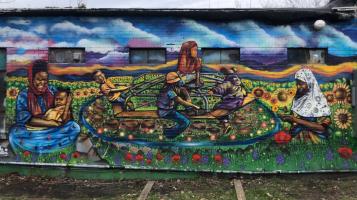
Liberation Through Imagination
Through poetry, portraiture and the portrayal of joy, Liberation Through Imagination celebrates youth and families in our community. Portraits of South End youth and families are depicted with pollinator wings that integrate shapes painted by community members, representing the artists’ Afro-pollinator theme in their Afro-futuristic style. The design also incorporates Afro-Indigenous and native botanical elements, while the poems are excerpted from the 2021 Juneteenth youth poetry contest winning submissions and rendered in the artist’s handwritten style.
The mural was commissioned to bring new life and energy to the old Street Department building and Burlington’s creative corridor at a critical time of reopening in the pandemic.
Designed by Jennifer Herrera Condry and Will Kasso Condry
Painted by Will Kasso Condry
Assisted by Jennifer Herrera Condry, Alexa Herrera Condry, Will Gebhard, Sierra Condry, Cameron Steele, Liz Amaral, Scottie Raymond, Will C, Jade Lai Xian, Julia Ciotti
Reference Photographer: Alexa Herrera Condry
Artwork Contributions from Burlington youth and families, and King Street Center youth
Reference Models: Cora Smith, Calvin and Franklin Millham-Berry, Hawa and Rukiya Awayle, Anyier Manyok, Mateo Baker, The Abdirahman family (Mohamed, Naima, Ahado, and Nasra)
Youth Poetry Excerpts: Nala Soleil Meyer, Aimerance Badibanga, Jaden Gomez, Mateo
Commissioned by Burlington City Arts, the Burlington Police Department, Burlington Permitting and Inspections, and the Church Street Marketplace
Juniper Creative Arts is a Vermont-based Black and Dominican family collective with a mission-driven practice of creating art that involves and celebrates historically excluded communities. They facilitate community mural projects with colleges and universities, K-12 schools, and community-based organizations, and educate on the history of muralism in the United States and the value of community murals and graffiti as forms of democratic art. They use visual art and murals to lift up the voices, images, and people that are often left in the margins. Juniper Creative consists of lead artist Will Kasso Condry, creative director and concept designer Jennifer Herrera Condry, and photographer and arts apprentice Alexa Herrera Condry. Their work centers on using mural arts as a vehicle for community-building, beautification, and healing.
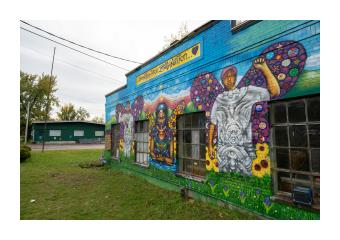
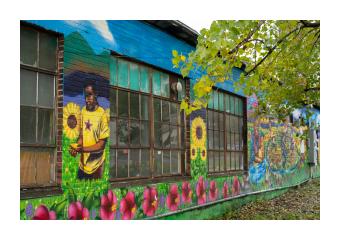
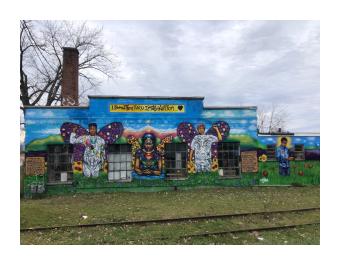
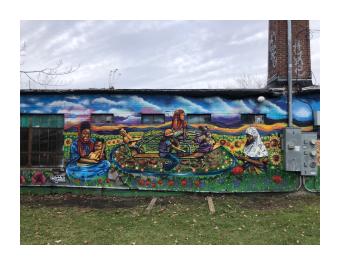

Fabric of Life
University of Vermont Medical Center, West Pavilion
2009, copper and steel
"The Fabric of Life" recognizes the power of healing and wellness that takes place at Fletcher Allen. An ornate quilt recognizes the potential of our hands and minds working together to create health and well-being.
Photo courtesy of Kat Clear


Katster Lock
2007, Painted Steel
Burlington Telecom was looking for a way to improve their front entrance and provide a bike rack for employees and building tenants. Kat Clear’s bike rack sculpture is modeled after a padlock. Her first bike rack sculpture, also a clever rendition of a bike lock, can be seen (used) on North Winooski Ave, in front of Radio Bean.


Kryptonite Lock
North Winooski Avenue
2006, Coated Steel
Until 2006, the conscientious bikers heading for the diverse array of businesses on the corner of North Winooski Avenue and Pearl Street tied their bikes to the trees and garbage cans lining the street. When a request for a bike rack was sent to the Department of Public Works, their Environmental Planner for pedestrians and bicycles saw the potential to further promote Burlington’s reputation as a bicycle friendly city and incorporate the street’s creative character by turning the rack into a public art project.


Watersheds to the Lake
2020, engraved Champlain Marble, gold paint, granite cobble
This public art installation was commissioned as part of the comprehensive redesign and renovation of Burlington’s City Hall Park. Blurring the line between art and infrastructure, Watersheds to the Lake highlights the relationship between Lake Champlain’s health and the impact of human activities along the watersheds that feed it. Each Champlain Marble disc installed within the cobble swale references the name of tributaries to the Champlain Watershed. Together, the cobble and the discs slow rainwater as it descends to the stormwater garden, representing both a literal repair and symbolic restoration of Lake Champlain. Similar
interventions installed throughout the park alleviate pressure on the City’s stormwater system and reduce runoff into the lake, helping to restore its water quality over time. The concept for the artwork was inspired by Kintsugi, a Japanese art form that repairs pottery cracks
with metal lacquer to reveal the essence of resilience.
Commissioned by Burlington City Arts




Kiss #2
Fletcher Free Library
1981, corten steel
Kiss #2 was installed during the construction of the Fletcher Free Library’s addition. The architect thought that it suggested a “hinge” between the new addition and the existing library and offered Kate Pond her first public art commission in Burlington. Dedicated to Helen Robins, former trustee of the library, the piece was sponsored by McAuliffes Paper Company and built with donations of steel from Edgecomb Steel, Vermont Structural Steel and Hazelett Strip Casting Company.
Kiss #2 is one of a series of sculptures comprised of shapes that nest together. Together is a sister piece that can be seen at Kate Pond’s studio at S.T. Griswold Company.
Photo by Michael Weizenegger


Koru Rising
237 North Winooski Ave
2015, Corten Steel
Koru is a Māori word for a spiral shape based on an unfurling fern frond, a symbol of creation. Pond's work is often influenced by cycles of nature, and rendered in corten steel, highlighting the contradictions of the human experience.




Silver School
149 Bank Street (Key Bank Plaza, off St. Paul Street)
1989, stainless steel
This piece was commissioned by the Bank of Vermont. Terry Boyle, the landscape architect for the small park where these fish reside, asked Kate Pond to create a piece that would provide a sense of intimacy for the setting. Kate chose fish as the subject for the fountain because of its proximity to the lake. The sisterpiece to this fountain, Skyway, is a flock of seagulls and can be seen at Kate’s studio at S.T. Griswold Company.
Another Kate Pond piece with a similar subject is Steelhead Trout, located in Winooski Falls Park. The piece was commissioned by Champlain Mill owner Ray Pecor, who shares the same love of fishing and many of the same fishing holes as Kate Pond. One year, Steelhead Trout was painted the same green as the park benches, and to preserve the integrity of the piece, Pond had to have the piece sandblasted back to its original steely color.
Photo by Michael Weizenegger


Threshold
BCA Center
2002, steel
With the design and construction of the Firehouse Center for the Visual Arts, Burlington City Arts designated 1% of its budget towards public art. Kate Pond’s foot grate Threshold represents one of several pieces on display in the Firehouse, each closely connected to the building’s architecture or design. Threshold’s design emphasizes the building’s details and reorganizes them into an abstracted steel artpiece that is integrated into the main entrance of the building.
Photo by Fred Stetson


Green State Gardener Mural
2017
Green State Gardener's solicited mural submission for its entrance that responded to their tagline, "Grow Your Own Health Revolution." Wiegers had studied natural sciences and incorporates botanical imagery regularly into her work. Additionally, her technique of painting on parachute cloth that can be adhered to any irregularly shaped surface made her proposal an excellent fit for this industrial facade.


Hilton Hotel Mural
2020
The Hilton Hotel commissioned this mural as part of a renovation of outdoor space at the hotel with the goal of warming up the entry experience from the rear parking garage, giving the hotel a more of a unique sense of place, and creating an element of surprise. Wiegers murals are created in her studio on parachute cloth and then installed on site when the painting is complete. The technique allows for installation on unusual surfaces and lasts much longer than paint applied directly to a surface. Wiegers other Burlington murals can be seen at Green State Gardener on Pine Street and throughout the UVM Children's Hospital.


Consequences
7 Marble Ave
2017, stone, steel
Building owner James Unsworth, the South End Arts and Business Association and 7 Marble Ave tenant Wagner Hodgson Landscape Architecture collaborated to redesign this corner into a sculpture park.
Mills designed his piece to "relate to the industrial evolution of Pine Street and potential ecological implications."


Equitorial Sundial
Gateway Park
2007, Stainless steel and granite
The dial features a stainless steel equatorial arc marked for standard and daylight saving times. No longitude correction is included as noon is centered on the equatorial ring. The gnomon is a strong stainless steel rod. The structural support is steel plate powder coated with red plastic. The dial sits on two large granite slabs. Terry Krinsky was the Landscape Architect and Carol Weston the project coordinator for the City of Burlington.



Bus Ball
Hills Agricultural Sciences Building
Lars Fisk is a 1993 UVM graduate known for his spherical sculptures. “Bus Ball,” brings an iconic memory of education to the campus, complete with green-leatherette seating inside. The ball, on loan to the University, balances on a knoll behind the Hills Agricultural Science Building. Another of Fisk's spheres, "Barn Ball," resides inside the Fleming Museum's lobby.

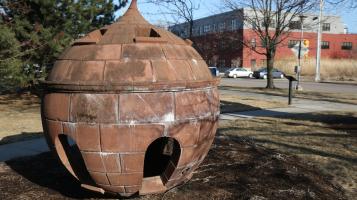
Brownstone Ball
Lakeside Avenue
Installed 2003, mixed media
Brownstone Ball’s original concept was inspired by the brownstone buildings in Brooklyn, NY, which was for a long time the blue collar community for industrial Manhattan. Brownstone Ball makes an easy symbolic connection to the Lakeside Avenue neighborhood, where Burlington’s industrial workers historically took up residence to work in the many factories that existed there. The General Dynamics building now sustains jobs in technological fields that have replaced many mechanized industries.
Installation commissioned by Gilbaine Properties for the General Dyanamics building on Lakeside Avenue and facilitated by Burlington City Arts’ Art in Public Places Program
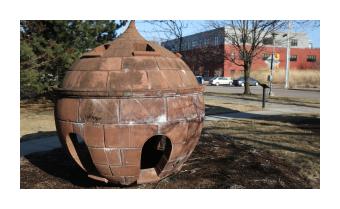
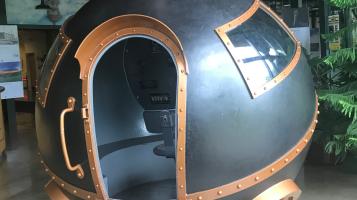
Train Ball
2007
Train Ball was originall commissioned by developers Melinda Moulton and Lisa Steele for Union Station, a former railway station. In 2017 the State of Vermont purchased the lower level of Union Station from Main Street Landing in preparation for the expected arrival of regularly scheduled Amtrak service into Burlington, and Train Ball was relocated to the first floor lobby of the Lake and College building. Fisk, graduated from the University of Vermont, was the artistic director of the legendary band Phish. His work and Redhook studio has been featured in the New York Times. More of his spherical sculptures can be found on the UVM campus and on Lakeside Ave in the South End.
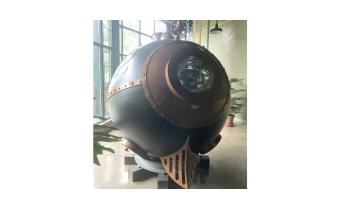
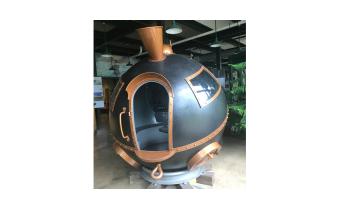

Mermaid House
84 North Avenue
2003, patinated forton with copper, stainless steel, fiberglass
This piece was commissioned by Housing Vermont in conjunction with architect Michael Wisniewski. To help tie the building to the site’s history and tradition, the sculpture includes physical features of the location’s past incarnation. For example, the hat worn by the mermaid is from an 1812 soldier’s uniform. More recently, there was a Shell gas station at this location, hence the scallop shell at the end of her tail. Her hair is made of jumping perch from Lake Champlain. The sculpture serves as a traditional architectural bracket, as well as a supporting figurehead for this building shaped like a ship.
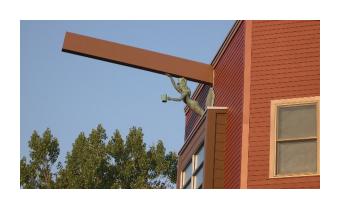


Pomerleau Neighborhood Park
Shelburne Road Plaza
1999, mixed materials
Pomerleau Real Estate President Ernie Pomerleau approached Burlington City Arts with a request to add a sculpture to the site of a shopping mall under redevelopment. The resulting sculpture garden, which serves as a bus-stop, pedestrian gateway to the mall, and vehicular gateway to Burlington, has become a landmark on Shelburne Road. The “pocket park” features concrete sphinxes perched on columns and has been lauded for the originality of the artwork and its integrated park design.
Commissioned by Burlington City Arts
Sponsored by the Antonio and Rita Pomerleau Foundation
Photo courtesy of Leslie Fry


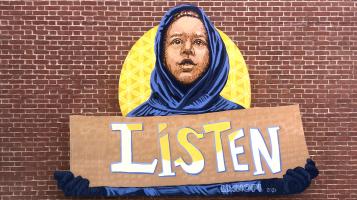
Listen
In Listen, viewers are invited to engage with the word “Listen” through the lens of a young boy. The interpretation of why he is asking us to listen to him is up to the viewer with the hope that the ambiguity causes them to pause and consider what messages are emanating from youth of color; especially boys. Is it that they want to be safe? Is it that they require respect? The sunlight is shining through the word as a way to emphasize how important it is for the older generations to actually pay attention to what the youth are telling us. It's as important as sunlight. The sunlight is shining through the word, emphasizing how important it is to pay attention to what the youth are saying.
The artist behind the moniker LMNOPI is Lopi LaRoe. Classically trained as an oil painter, LMNOPI uses her artistic skills as a way to amplify messages emanating from within movements for social, economic, racial and climate justice. Her primary mediums are painting and printmaking, which she utilizes to create both sanctioned and unsanctioned interventions in the commons. Prior to creating the street artist persona LMNOPI in 2009, she has been a community organizer, humanitarian worker & civilly disobedient activist over the last four decades, standing elbow to elbow with the people & communities she depicts in her work. A terrain of strength and humor, defiance and resilience, love and bravery emanates from the faces of the women and children she paints. LMNOPI has created over 20 murals across the US since 2009.
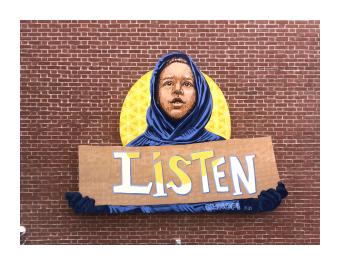

Humming Bird
2015
This piece was commissioned by the owners of American Flatbread. It was the largest work Lacy had done to date when completed. Her work is often inspired by the natural world, but avoids messaging. Her signature geometric style can also be found on a more abstract piece commissioned by Dealer.com for their silos in the South End.


Inside Out
2015
"Inside Out" was commissioned to represent the connection between Dealer.com and its surrounding community. The content of the mural is inspired largely by the interior of the company’s building and the unique silo structure on which it is painted. The undertaking was masterminded by Dealer.com's former Director of Corporate Social Responsibility, Jill Badolato. Badolato is known for her mural passion that connects the medium to community. Examples include a role in producing Above the Radar International Graffiti Festival on the King Street dock, facilitating the Outdoor Gear Exchange mural on Cherry Street, and founding Mission Murals, a fundraising collective that brings murals to non-profit spaces.


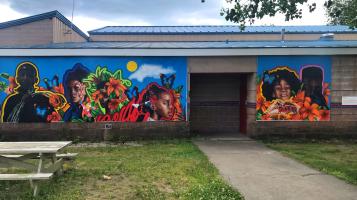
A Love Supreme
Speaking directly to the youth of the Boys and Girls Club, N Carlos Jay portrays children of color in forward growth and happiness through the various forms of love. In the artist's words, “Showing our love for each other in public ways tells the world that we are a people of happiness and joy. We are the change through love. By living our lives boldly, we are sharing our culture and traditions with the communities we live in. Teaching our children through the music we listen to, the foods we eat, the way we celebrate holidays, and telling family stories passes down great value and lets our own children know that we are a part of the radical change our ancestors hoped for.”
In Jay’s illustrative narrative, parents are signified as flowers, butterflies signify our children and pollen signifies love. Butterflies depend on flowers for food while flowers depend on butterflies to reproduce. Butterflies help flowers reproduce by spreading pollen from one flower to another. As the butterfly feeds, it picks up pollen from one flower and deposits it on another flower. The blackbirds signify family and bonding while food signifies love. Blackbirds congregate for food and protection. While some birds migrate alone, blackbirds find strength in numbers and they cooperate to find food (or love in this case).
Referencing Burlington’s multi-racial community, Jay incorporates different shades of black people within the design to further connect with his young audience.
Commissioned by Burlington City Arts and the Office of Racial Equity, Inclusion and Belonging Juneteenth 2022
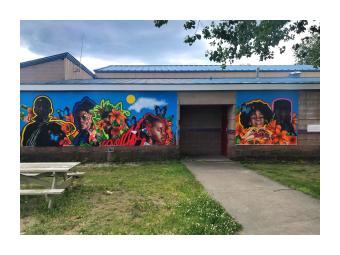
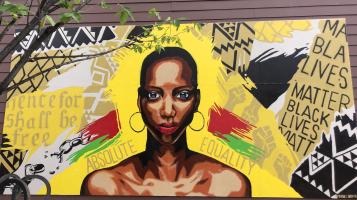
Absolute Equality
Absolute Equality draws on historical language, imagery from African culture, and symbols of Black equality to celebrate the Juneteenth holiday and Black emancipation.
A portrait of a non-specific Black woman centers the work as a symbol of Black empowerment, inviting people of color to see themselves in the image. Language from the Emancipation Proclamation, “henceforward shall be free,” represents the first legal basis for Black liberation from slavery. “Absolute Equality” is taken from the proclamation that Union soldiers read to the Black citizens of Galveston Texas on the original Juneteenth in 1865, letting them know for the first time that they were free from slavery. Clenched fists and the words “Black Lives Matter” symbolize resistance and the ongoing fight for Black equality, and also celebrate the progress that has been made towards the “absolute equality” that was promised on Juneteenth. A brushstroke motif and traditional African fabric patterns modeled after a West African batik process reference self-expression, cultural identity, and the richness of Black history.
Oh My! Murals is a New York City based mural painting team comprised of Tyler Ives and Sara Lynne Leo that originated in East Harlem to provide affordable, vibrant artwork to local small businesses. Oh My! Murals has now painted over a dozen murals in the New York City area and throughout New England. Tyler Ives is a mural painter, protest artist, and sculptor – winning an Emmy award for his work as the prop-maker on HBO’s Sesame Street. As a queer artist, Tyler’s personal artwork is outspoken against discrimination and inequality. Sara Lynne Leo is a mural painter, street artist, and mental health advocate, achieving wide-spread attention for their hand-painted and wheat-pasted street art throughout New York City. Sara Lynne is a gender non-conforming artist, and their artwork comes from their personal experience living with mental health issues. Sara Lynne’s artwork takes the form of hand-painted comics that offer witty, sardonic, and often therapeutic messages, giving the general public a platform to discuss their struggles with mental health as well as the general the toils of everyday life.
Commissioned by Burlington City Arts and the Office of Racial Equity, Inclusion and Belonging
Juneteenth 2021
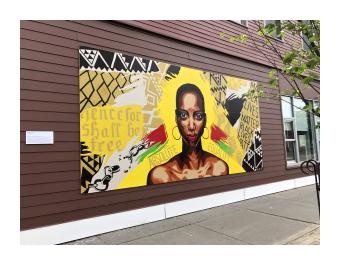
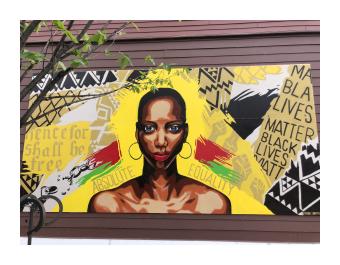

Equinox Sculpture
Paul Aschenbach
Battery Park Extension, Battery Street
1974, marble
Paul Aschenbach didn’t believe in gallery culture and focused his attention on making work solely for outdoor sites, and ultimately, collaborative pieces. This piece was created in collaboration with Bill Ford, Terry Dinnan, John Watenberg, Bob Vesely, and several of Aschenbach’s UVM students. The design consists of five groupings of marble intentionally placed as a way to view the sunset at the equinox through the crevices carved in the stones.
Photo by Michael Weizenegger

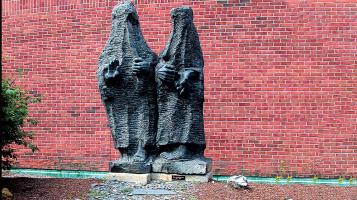
Road to Emmaus
Saint Michael’s College
1990, black granite
This stone sculpture was commissioned by Saint Michael’s College when a new academic building was constructed, thereby creating a courtyard on campus. The story of the disciples of Christ who recognized the Lord on the road to Emmaus after his crucifixion is an important message within Christian teachings and a very appropriate subject for an institution of higher education in the Catholic tradition. The sculpture was created on site so students and the campus community could observe how it progressed. This artwork is one of the last commissioned pieces completed by Aschenbach before his death and may well be a most appropriate finish for an artist who began his career in liturgical art.
Photo by Michael Weizenegger

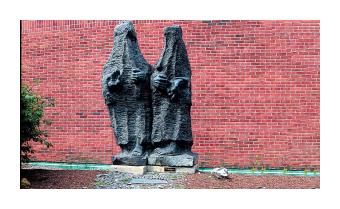

Three Children
First Congregational Church
1968, corten steel
This piece was commissioned and donated by Dr. and Mrs. John French, members of the congregation, in appreciation of the Christian teachings presented to the children of the church. Paul Aschenbach initiated his career as a liturgical artist. Many of his early pieces can be found in churchyards or religious sites.


Tree of Knowledge
UVM Bailey Howe Library
c.1963, bronze
Paul Aschenbach grew up in Randolph, Vermont as the son of a blacksmith. He studied at the Rhode Island School of Design and started his career as an artist making liturgical pieces. He became a professor at UVM, where he taught sculpture for 30 years. The Tree of Knowledge was given to UVM by the class of 1962.
Photo by Michael Weizenegger


Battery Park Extension Sculptures
c. 1974, marble
This grouping of 5 carvings along the Battery Park Extension park were likely created in some response to the Circumferential Highway, which at one time planned to turn Battery Street into a highway. Aschenbach was particularly interested in organizing multi-artist public art symmposia around road side art to "make travel digestible." One such gathering yielded a series of 18 sculptures by international artists along interstate 89, of which only a few remain in public view.


Ethan Allen
Greenmount Cemetery, Colchester Avenue
1873, marble
This statue was erected in memory of Ethan Allen, best known as the infamous leader of the Green Mountain Boys, a citizen’s militia charged with protecting ownership of what is now Vermont against the claims of ownership by the corrupt government of New York. As an outspoken, well-read and politically active personality, he made significant contributions to Vermont’s early history and the attitudes of independence that still pervade Vermont today. While he was rumored over six feet tall, no portrait of Ethan Allen exists, and depictions like this one were defined by a traditional commemorative style rather than accurate representation.
Photo by Michael Weizenegger


Chief Greylock
Battery Park, Battery Street
1982, wood
Peter Toth created and donated a sculpture in every American state and Canadian province to commemorate the legacy of the Native American people. The Abenaki tribe of this area decided to name the piece after their last great warrior, Chief Grey Lock. It was Toth’s 47th statue in honor of Native Americans.
Photo by Michael Weizenegger


Stained Glass Skylight
Burlington Public Works and Parks and Recreation Offices, Pine Street
2000, stained glass
With the construction of Burlington’s Central Maintenance Facility for the Department of Public Works and Department of Parks and Recreation, Burlington City Arts commissioned a stained glass skylight for the public reception area that depicts a colorful map of Burlington, Lake Champlain, and the surrounding communities.
Photo by Michael Weizenegger



Radiant State
By Phoebe Lo
May 2024, plywood, acrylic, LED lights
Patrick Leahy International Airport
1200 Airport Dr, South Burlington, VT 05403
With an enchanting color palate, minimalist forms, and multi-layered surface, artist Phoebe Lo creates an evocative tableau celebrating the transformative power of travel and the cultural richness of our region. An interactive, illuminated mural, Lo's work showcases the vibrancy unique to Vermont, and the inviting worlds for visitors and locals to discover and inhabit together.
Commissioned by Patrick Leahy International Airport.


City Market
South End City Market
2017
When planning its second location in the South End, integrating art was a way for City Market to continue the theme of making the Co-op welcoming to all Members and customers, and to celebrate the reputation of its new location in the South End as an arts destination. They selected two artists to install murals on the East and North sides of the building, and incorporated more of Tara Goreau's work inside the entry way. The building itself, designed by Freeman French Freeman, was also intended to be a subtle art piece telling the story of the Co-op's mission. Everyday scenes from local farms were digitally manipulated into an abstract pattern; the images were then printed on metal panels and mounted on the building’s exterior walls.


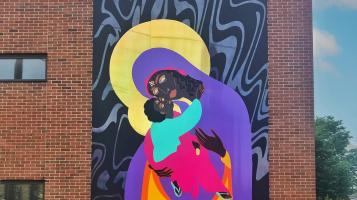
Black Freedom, Black Madonna & the Black Child of Hope
Black Freedom, Black Madonna & the Black Child of Hope explores the Haitian influence on Black liberation and its revitalization of the Juneteenth message for Black people in the Americas and in the world.
A revered Vodou figure, Ezulie Dantor, is portrayed as a Black Madonna holding a child as a symbol of maternal love, interconnectedness, and transformation. The image of Ezulie Dantor references the association between Vodou and Haiti’s historic victory for independence from France in 1804. In the spirit of Burlington’s Juneteenth theme “A Love Story,” the image also represents the artist’s own identity as both child and caretaker, and the universal bonds between the young and the old. Juxtaposing the physical and metaphysical and the scientific and spiritual, Black Freedom, Black Madonna & the Black Child of Hope ties the human experience together and offers an optimistic view of the future.
This mural is a collaboration between Brice and artist Josephine Bunnell and was produced at Generator, Burlington’s community makerspace.
Commissioned by Burlington City Arts and the Office of Racial Equity, Inclusion and Belonging Juneteenth 2022
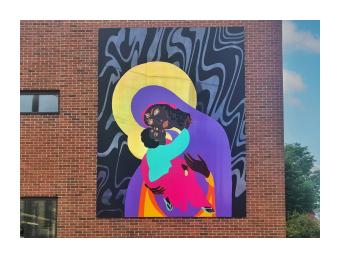

City Place Community Art Murals - East
McClure Senior Center
2015
Three sides of this building hosts murals created by King Street Center Youth, Burlington High School Students and Reta A. Masters at the McClure Senior Center in 2015. At that time, the plan for the stalled City Place renovation had been in early stages.
Burlington City Arts coordinated their development for the mall owner, working with teaching artist Alyssa Faber, who facilitated artmaking workshops with each group around the theme, “What does Burlington mean to me.” The mural facing Lake Champlain was created by Burlington High School Art 2 Honors students Georgia Essig, Alicia Breen, and Nikki Miller. The mural facing south was created by King Street Youth Barni Hassan, Nikkiah Atwood and Zanaia Hanmond. The mural facing east was created by Reta A. Masters at the McClure Senior Center.The fourth side of the building was already wrapped by in a photo muralby L.L. Bean.
From high-resolution photos, the selected images were enlarged and printed by Sign Depot of Vermont, who installed the images in sections over the walls and windows with a material that does not obscure the windows from within.


Arete Blu
Davis Center
2017, Brazilian blue granite
Richard Erdman studied at the University of Vermont and gifted this piece along with two others to the University, where it now resides as a centerpiece of a plaza outside the Davis Student Center. Erdman works from studios in both Williston, Vermont, and Carrara, Italy. Known for their curves and geological influence, Erdman"Arete Blu" is unique in that it is one of only four sculptures Erdman has carved from blue granite.


Belladonna
University Green
2004, bronze
Richard Erdman studied at the University of Vermont and gifted this piece along to the University. He works from studios in both Williston, Vermont, and Carrara, Italy. Erdman’s marble and bronze sculptures are known for their curves and geological influence. Arete Blu is unique in that it is one of only four sculptures Erdman has carved from blue granite.


Ira Allen
Sherry Fry
UVM Green, N. Prospect Street
1921, bronze
Ira Allen came to Vermont to work with his brothers as a surveyor for the newly forged northern territory. Brother of famed Green Mountain Boy, Ethan Allen, Ira Allen acquired his own source of fame as the founding father of the University of Vermont Medical College. This piece was donated to UVM by James Wilbur in 1921.
Photo by Michael Weizenegger


Primavera
UVM Greenhouse Complex
2009, bronze
The University of Vermont purchased this piece in 2010 from alumni Richard Erdman. The piece celebrates spring, fitting for its location in a garden near the department of plant biology and plant and soil science.


Deep Conversation
October 2024, bronze and Vermont Monkton Quartzite
Perkins Pier Park


Conant Metal And Light
Steve Conant developed and manufactured an array of high-end lighting, weather instruments, clocks, and bird feeders for many years in this building under the heading Conant Custom Brass. In 2008, he sold the outdoor weather instrument business and reopened as Conant Metal and Light, focusing on his original interest in one-of-a-kind products and art pieces. This left room for the remainder of the building to be repurposed as artist studios and spaces for small creative businesses, solidifying its place as a visionary anchor for the arts and enterprise zone. Conant employs many artists and fabricators, resulting in an informal makerspace and training grounds for public artists.



Winged Monkeys
Union Station, 1 Main Street
1975, steel
The Winged Monkeys of the clock tower were originally made in 1975 for a waterbed store in downtown Burlington called “The Emerald City of Oz.” This piece actually boasts a fascinating story of theft. After the waterbed store moved to the Shelburne Road, the male monkey was stolen from the roof and disappeared. Months later, the thieves were nabbed in a stakeout and the piece was returned to the store owner. In 1997, the waterbed store closed and the monkeys were taken to the roof of One Main Street.
Photo by Michael Weizenegger

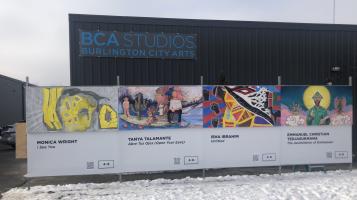
4 x 8 Mural Project [Legacy]
This temporary mural installation presented unique and varied perspectives on race and belonging by four artists: Tanya Talamante, Emmanuel Christian Tedjasukmana, Isha Ibrahim, and Monica Wright. Each artist employs a distinct approach to working the mural surface, accompanied by a deeply personal narrative that heightens the emotional resonance of each image. As a group, the murals assert the power of individual stories to help shape perceptions and conversations about race in our public spaces. The works traveled to multiple outdoor locations in Burlington before returning to the artists.
These murals are the first in a series of public art partnerships between Burlington City Arts and Burlington’s Office of Racial Equity, Inclusion, and Belonging. The goal of the partnership is to create space for Black, Indigenous, and other People of Color to share their unique stories with the world and to create visibility, through artistic expression, for the impact racism has on our society.
Monica Wright
I See You
Monica Wright is a designer and artist from Vermont. Her work is more recently influenced by her experiences as a biracial woman, the violence perpetrated against BIPOC women, and a need to further understand the impact of colonial power on global sustainability. In 2017, she earned a BFA in Fashion Design from the New School, Parsons. Her interest in sustainable systems, especially within the fashion industry and the elimination of textile waste, has led her back to the east coast where she’s developing her own projects, and navigating her next steps back into the field of fashion.
https://soundcloud.com/user-624558738/m-wright-final-mural-audio/s-M1B4kpCq6RT
Audio Transcript
The I See You mural is like a coming out. I’m coming out as a bi-racial person. Physical appearance says what we are before we even have the chance to verbally speak. I am Filipina and I am White. The mural is inspired by my own experience, and the effects of growing up in a predominantly white environment. Soft sculpture elements have been both hand- and machine-sewn to create a mixed media painting. My background is in fashion design, and my creative interests include sustainable production systems and textiles. On an ending note, I wanted to express my gratitude for the local BIPOC community. During a time of isolation and fear finding connection amongst you all has kept me hopeful.
Tanya Talamante
Abre Tus Ojos (Open Your Eyes)
Tanya was born in Tijuana, Mexico. Her career as a professional artist took off in Los Cabos, Mexico, where she is known as a one of the first artists of the Baja Art Movement. Flowers, native Indians, and bright colors were consistent themes in her early collections. She obtained her bachelor degree in product design from the Universidad Autonoma de Guadalajara and later attended the School of Fine Arts in San Miguel de Allende. From 2001-2010, Talamante lived in Arizona, California, Maine, and Vermont. In 2010, she settled back again in Los Cabos, where she founded Studio TT Art School and Gallery, which evolved into the first formal school of art in Los Cabos. Now her studio is in Vermont and she will be teaching art in local schools.
https://soundcloud.com/user-624558738/talamante/s-VI2x6CpvpIq
Audio Transcript
Abre Tus Ojos. I think the role of artists in social change is very important in this time. I’m very fortunate to be able to work in two countries and see firsthand the frustration and racial injustices of the world we live in. Personally, I think we as artists need to shift the way people think about the world. It’s our job to imagine the possibilities, shift the thinking of individuals and situations to our presentation of them, to explore the gray areas that make humans complicated and interesting, and to uplift the hope and resilience of communities we are part of. In my work, Abre Tus Ojos (Open Your Eyes), I want to recognize humanity as a whole. I want to challenge our own entrenched ways of thinking as people, parents, grandparents, and as a society.
Isha Ibrahim
Untitled
Isha Ibrahim is a 17-year-old Muslim woman and the first generation of her family to grow up in America. Her parents were from Somalia and she was born in Kenya. She is currently a senior at Burlington High School.
https://soundcloud.com/user-624558738/ishas-audio/s-oWDxMWrJ5q4
Audio Transcript
For this mural I had the idea of representing my background as a Black Muslim girl growing up in America. I used many things like the map of Kenya and Somalia, Arabic, and the hijab. I wanted this to be more abstract than anything. I have the colors red, whit, and blue to represent my American side. And I have the “Resist” hand symbol to represent the Black Lives Matter movement in America. Another thing I have in this mural is the tribal print usually seen on traditional Somali dresses to represent my African background. Looking at the sketch, you will see an image of a Muslim girl wearing a hijab and what looks like a blindfold on her eyes. The blindfold is red, white, and blue to represent America. This can symbolize that I’m carrying my culture with me, but I see the world through an American system. The Arabic written says “bissmilahi rahmani Rahim,” and that translates to “in the name of Allah the gracious the most merciful.” This is a phrase used before each chapter in the Quran, and is used daily by Muslims.
Emmanuel Christian Tedjasukmana
The Assimilation of Emmanuel
Emmanuel Christian Tedjasukmana is a nurse, designer, and artist originally from Michigan who lives and works in Burlington. Prior to receiving a Master of Fine Arts degree in Emergent Media from Champlain College in 2019, he graduated with a BS in Nursing and a BA in Spanish in 2010, and has worked at UVM Medical Center as a nurse since 2011. He is most interested in finding various methods to meld art, activism, and nursing together, and his artwork and designs frequently employ symbolism related to his personal experiences. He is a first-generation American, born to parents who are Chinese-Indonesian immigrants.
https://soundcloud.com/user-624558738/the-assimilation-of-emmanuel/s-axVEIM5X4Hj
Audio Transcript
My mural, entitled The Assimilation of Emmanuel, was a chance for me to take an introspective look at the way my assimilation into American culture had an impact on my identity. It was also a medium in which to visually convey my family’s story and provide a way to provoke further thought and conversation on the topics of assimilation, identity, and belonging, and the stigma of accents. It also had the purpose of calling attention to the various sacrifices to identity that migrant families must endure in hopes of achieving this wildly distorted concept known as the “American Dream.”
Through the symbolism in my painting, I wanted to highlight the sacrifices that my mother and father (who in the mural are both represented by a Chinese and Indonesian mythological figure) underwent as they made the difficult decision to assimilate our family into American culture through the act of linguistic assimilation. To achieve this meant that they would withhold our native language of Bahasa (Indonesian) entirely from us and focus on only teaching us English (which is symbolized by the tying of my father’s tongue and the suturing of my mother’s mouth shut). They believed that in doing this, their children wouldn’t exhibit any signs of a foreign accent with the hopes of having us fit in more—and as a result, be less likely to be discriminated against or be made fun of.
Despite this sacrifice to curate or 'knit' our tongues and protect us, we would all come to the realization that regardless of how well we spoke English or identified with American culture or were educated through the American school systems, the sacrifice was in vain—and we would regularly be viewed as a “foreigner”: often based solely on our physical features or by how difficult it was to pronounce our last name. We were not viewed as Americans, but rather as “bananas”: a slur meant to symbolize that we were yellow on the outside but white on the inside. This slur would not only be used against us by Americans as a way to insult us, but by Chinese and Indonesians as well in order to alienate us and make us feel like we also did not belong.
It is through this canvas that I want to draw attention to the fact that even though many people still encourage and romanticize the colonizing practices of assimilation as this wonderfully enlightening 'saintly' and almost a redeeming act from one’s “strange,” “uncivilized,” and “foreign” culture, you are in fact robbing an individual of their identity and depriving them of their existence, their connections, and their rich heritage and culture that society has not taken the time to understand or appreciate—thus rendering us silent.
Being that we are all immigrants in one way or another, why are we still under this harmful misconception that one culture must conform to another in order to have a sense of belonging and security? We need to redefine our view of what an American looks like and is, because what does it even mean to be American in this day and age anyway?
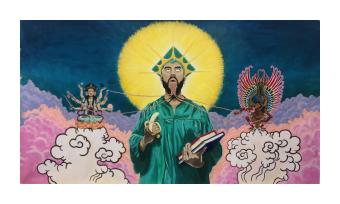
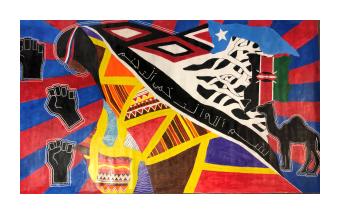
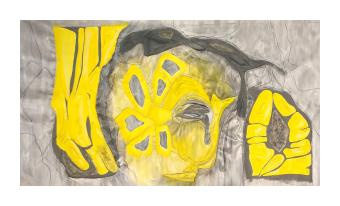

City Market
2013
City Market commissioned Goreau to paint the entrance of the member owned coop to engage shoppers and artists in a distinct experience. City Market continued its arts incorporation when it opened a second location in the South End in 2018, featuring murals on the inside and outside of the building, including another by Goreau.

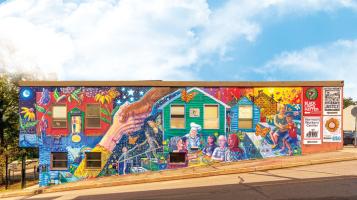
Turning Point Center Mural
2019
This mural was commissioned by Champlain Housing Trust for the building occupied and now owned by the Turning Point Center. The mural celebrates the Turning Point Center and the housing trust's shared missions and the housing trust's 35th anniversary. The building is also home to Black Lives Matter of Greater Burlington, Migrant Justice, the Vermont Workers' Center and 350Vermont.

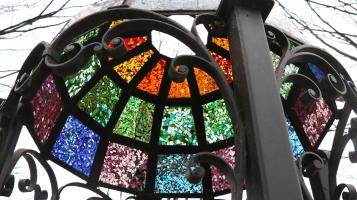
O.N.E. Der Dome
Hyde Street Triangle Park
2010, stained glass and steel
With help from a CEDO grant, VSA arts of Vermont’s four-year goal of erecting a dome with stained glass panels made by adults with developmental disabilities in Burlington’s Old North End came to fruition in the spring of 2010.
The stained glass panels in the sculpture were made by community artists in VSA Arts of Vermont classes presented in partnership with Howard Center Developmental Services and Champlain Community Services, and taught by Terry Zigmund of Burlington Community Glass Studio. The steel dome was made by John Marius of Champlain Metals.
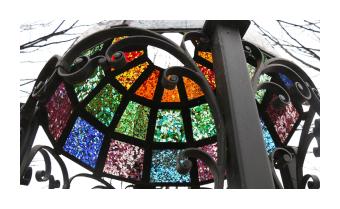
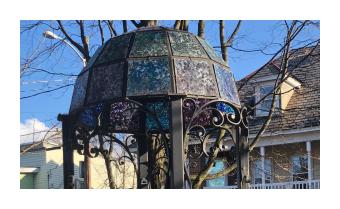
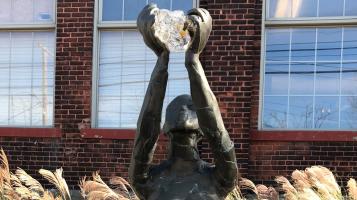
Camille
7 Marble Ave
2017, bronze
Building owner James Unsworth, the South End Arts and Business Association and 7 Marble Ave tenant Wagner Hodgson Landscape Architecture collaborated to redesign this corner into a sculpture park.
Vendituoli is known for the large, steam-punk-style animals he has constructed for the South End Art Hop, but his work in metal spans many themes.
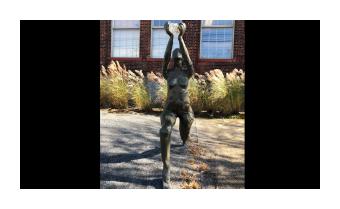

Democracy
1990, granite
This piece was commissioned by Ray Pecor with the development of the Courthouse Plaza. The concept for the piece clearly focuses on the purpose of the courthouse – seeking justice through democracy. The theme of democracy as a “puzzle” reflects the events of the early 1990’s, as the collapse of the Berlin Wall and the disassembly of the Soviet Union brought the possibility of democracy to two countries in need of “puzzle solving.”
Photo by Michael Weizenegger


Shapes and Colors
Will Gebhard
North Union and North St
2018, painted plywood shapes
This installation was created as a participatory event during the Ramble, an annual event that brings residents in the Old North End together to create and celebrate. Gebhard's project was supported by a grant from the BCA Community Fund, a grant program that supports projects that connect art and community.





